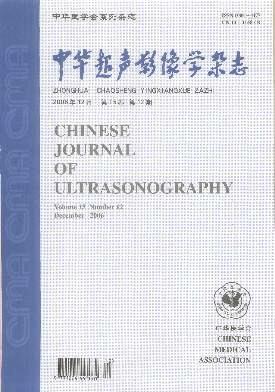Diagnostic value of the combining contrast-enhanced ultrasonography and gadoxetic acid-enhanced magnetic resonance imaging in the diagnosis of early hepatocellular carcinoma
Q4 Medicine
引用次数: 0
Abstract
Objective To compare the diagnostic efficacies of contrast-enhanced ultrasonography (CEUS) and gadoxetic acid-enhanced magnetic resonance imaging (EOB-MRI) in the diagnosis of liver nodules ≤2.0 cm in patients with cirrhosis, and to explore the clinical values of combining the arterial phase of CEUS and hepatobiliary phase of EOB-MRI in the diagnosis of early hepatocellular carcinoma (HCC). Methods One hundred and thirteen nodules with diameters lower than 2.0 cm in 98 patients from February to December 2016 in Tianjin Third Central Hospital were included in this retrospective study. The enhancement patterns of nodules in CEUS and EOB-MRI were analyzed. The reference standard was pathological diagnosis or substantial lesion growth at a follow-up of at least 6 months. The efficiencies of CEUS and EOB-MRI in the diagnosis of liver lesions with a diameter lower than 2.0 cm were compared. A new diagnostic strategy, which combines the arterial phase of CEUS and hepatobiliary phase of EOB-MRI was presented to diagnose the early HCC in this study. Results The area under the ROC curve of CEUS and EOB-MRI were 0.858 and 0.814(P>0.05), the sensitivity were 79.1%, 81.4%, specificity were 92.6%, 81.5% and diagnostic accuracy were 82.3% and 81.4%, respectively. By combination of CEUS and EOB-MRI, the area under the ROC curve was 0.831, without difference from CEUS, EOB-MRI (0.831 vs 0.858, 0.814; all P>0.05); its sensitivity was 66.3%, specificity was 100% and diagnostic accuracy was 74.3%. The area under the ROC curve of the new diagnostic strategy, combining the arterial phase of CEUS and hepatobiliary phase of EOB-MRI was 0.934, which was larger than that of CEUS, EOB-MRI and the combination of CEUS and EOB-MRI(0.934 vs 0.858, 0.814, 0.831; all P<0.05). The sensitivity, specificity and diagnostic accuracy of new strategy were 94.2%, 92.6% and 93.8%, respectively. Conclusions The new diagnostic strategy based on the arterial phase of CEUS and hepatobiliary phase of EOB-MRI improves the sensitivity and accuracy in detecting small lesions, which can be used as a complementary diagnostic enhancement pattern for lesions with an atypical enhancement pattern in CEUS or EOB-MRI. Key words: Contrast-enhanced ultrasonography; Gadoxetic acid-enhanced magnetic resonance imaging; Micro hepatocellular carcinoma; Diagnosis超声造影和钆酸增强磁共振成像对早期肝细胞癌的诊断价值
目的比较超声造影(CEUS)与加多西酸增强磁共振成像(EOB-MRI)对肝硬化患者≤2.0 cm肝结节的诊断效果,探讨超声造影动脉期与EOB-MRI肝胆期联合诊断早期肝细胞癌(HCC)的临床价值。方法对天津市第三中心医院2016年2月至12月收治的98例直径小于2.0 cm的113例结节患者进行回顾性研究。分析超声造影和EOB-MRI对结节的增强模式。参考标准为病理诊断或随访至少6个月的实质性病变生长。比较超声造影和EOB-MRI对直径小于2.0 cm的肝脏病变的诊断效率。本研究提出了一种新的诊断策略,将超声造影的动脉期和EOB-MRI的肝胆期相结合来诊断早期HCC。结果CEUS和EOB-MRI的ROC曲线下面积分别为0.858和0.814(P < 0.05),敏感性分别为79.1%、81.4%,特异性分别为92.6%、81.5%,诊断准确率分别为82.3%和81.4%。CEUS与EOB-MRI联合应用,ROC曲线下面积为0.831,与CEUS、EOB-MRI无差异(0.831 vs 0.858, 0.814;所有P > 0.05);其敏感性为66.3%,特异性为100%,诊断准确率为74.3%。新诊断策略下CEUS动脉期与EOB-MRI肝胆期合并的ROC曲线下面积为0.934,大于CEUS、EOB-MRI及CEUS与EOB-MRI合并的ROC曲线下面积(0.934 vs 0.858、0.814、0.831;所有P < 0.05)。新策略的敏感性、特异性和诊断准确率分别为94.2%、92.6%和93.8%。结论基于CEUS动脉期和EOB-MRI肝胆期的新诊断策略提高了小病变的检测灵敏度和准确性,可作为CEUS或EOB-MRI非典型增强病变的补充诊断增强模式。关键词:超声造影;Gadoxetic酸增强磁共振成像;微肝细胞癌;诊断
本文章由计算机程序翻译,如有差异,请以英文原文为准。
求助全文
约1分钟内获得全文
求助全文
来源期刊

中华超声影像学杂志
Medicine-Radiology, Nuclear Medicine and Imaging
CiteScore
0.80
自引率
0.00%
发文量
9126
期刊介绍:
 求助内容:
求助内容: 应助结果提醒方式:
应助结果提醒方式:


